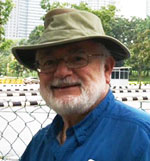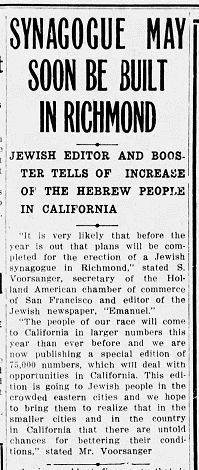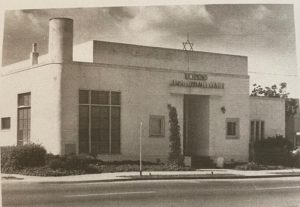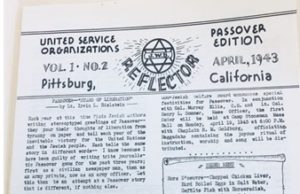By Oliver B. Pollak


RICHMOND, California — The headline in the adjoining news clipping is hype. “May” is not “will” or “shall.” Booster describes real estate developers, hucksters and visionaries who wanted to profit from growing communities and increases in real estate prices. Saul Voorsanger, who emigrated from Holland with his wife Sarah in 1893, promoted the growth of the Jewish population. He was a salesman and publicist and the brother of Temple Emanu-El’s Rabbi Jacob Voorsanger. The rabbi started Emanu-El, San Francisco’s weekly Jewish newspaper in 1895 and died in 1908. Sol, Saul or S. became editor. During 1912 several newspapers reported Voorsanger’s visiting chambers of commerce in San Diego, Visalia, Fresno, Modesto, Kings, San Joaquin, and Dinuba. He solicited advertising for a special 75,000 copy edition of Emanu-El to recruit better-off Russian Jews to buy and farm California land, a chimera. The plan for Richmond conformed with early 20th century Jewish emigration ideas to avoid ghettoizing Jews in Eastern seaboard cities. In 1929 Sol led Yom Kippur services for 64 Jewish prisoners at San Quentin.
Houses of worship dotted Richmond’s cityscape. Point Richmond’s hills further elevated their spires. Newcomers were attracted by the presence of co-religionists. Churches provided comfort for strangers who sought compatible neighbors and community to observe Christian and Jewish celebrations. Spiritual leadership provided solace in times of stress. Real estate agents extolled the advantages of certain neighborhoods.
Population growth drove prosperity. President Theodore Roosevelt, whose term ran from 1901-1909, was a conservationist, and a proponent of large families. During the early 20th century newspapers covered the birth reports of Richmond Health Commissioner Dr. Charles R. Blake, a Boy Scout promoter. Speculators and real estate developers wanted to sell land at increasingly higher prices. The construction industry looked to wood frames, bricks and mortar. They made plans for schools, libraries, colleges, healthcare, and other community amenities. Newspapers avidly supported civic development. Property tax funded education, fire, police, roads and other necessities.
The 1907 Richmond City Directory stated “it is safe to predict the population will exceed 20,000, and may reach 30,000” in 1910. Expectations fell well short, the 1910 Census reported 6,802 inhabitant. The Directory listed the First Methodist Church (1900) and Our Lady of Mercy Catholic Church (1902). Baptist, Christian Science Church, Episcopal, Methodist, Presbyterian, and Seventh Day Adventist soon followed. There were Jewish proprietors among the 36 saloons, 29 real estate agents, 13 insurance agents, 12 restaurants, and three undertakers.
Bay Area newspapers noted where Jews could worship and sporadically described the Jewish holidays. The December 3, 1912 Richmond Daily Independent discussed Chanukkah in an article headlined “Old Hebrew Festival will be Held Tomorrow” and “Special services in all synagogues of San Francisco will celebrate the festival.” The Oakland Tribune announced plans in 1913 to construct a new Oakland synagogue. The Daily Independent reported in 1914 “Many of the local merchants will attend the [New Year] services at the Synagogue, Ninth and Castro Streets, Oakland.” The 1916 San Francisco and Bay Cities Jewish Blue Book listed eight San Francisco synagogues and temples, three in Oakland and one in Berkeley. Taking a ferry from Richmond to pray was impractical, Berkeley and Oakland were a bit of a shlep. Perhaps lay leaders or seminary students led services in private homes or in temporary rented space. In 1919 Yom Kippur would find Jews “praying in the various synagogues about the bay.”
My two-year-old project writing the history of the Institute for Historical Study founded in 1979, included reading Kansas and Me, Memories of a Jewish Childhood by Annette Peltz McComas published in 1995 by Borgo Press in San Bernardino as No. 10 in their series “Studies in Judaica and the Holocaust.” It is printed in excruciating small type. McComas belonged to the IHS from 1988 to her death in 1994. Written by an octogenarian losing her sight she mined her impressionable childhood memories. Her historical novel turned it into a nonfictional account of Jewish family life. A ‘briefly noted’ review called it an ‘autobiography.’
McComas was born in 1911. Her family moved from Santa Cruz to Hutchison, Kansas in 1917. There were about 27 Jewish families amidst a population of 20,000. By the time she left to attend the University of California in Berkeley in 1928, there were 50 Jewish families within a population of 30,000. This sounds so much like Richmond’s Jewish growth. Hutchinson’s Jews tried to combine the barely observant and the Orthodox by starting a Sunday school, minyan, and importing a student Rabbi from Wichita; it did not last long. Today the closest synagogue to Hutchinson is in Wichita.
Kansas was a Dry state (no alcohol) with fundamentalist preachers. Antisemitism flourished. McComas e spent much time with her dog Kutcher and at the 1902 Carnegie Library where she read Oz and Tarzan books. All her girlfriends were Christians. McComas, a dramatist, navigated childhood and adolescents and returned to Berkeley in June 1929, on the cusp of the Great Depression.
She described her 18-year marriage as disastrous. Her son died at the age of 37. She was going blind. This challenged optimism. She wrote “I increased my skills sharply as a writer and published a few meaningless little stories in meaningless little magazines.” This book is far from meaningless.

Perhaps the first report of Jewish worship in Contra Costa County appeared in a newsletter published at Fort Stoneman where in 1943 Jewish troops in transit to the Pacific Theater enjoyed Passover.
The Second World War influx of Jewish servicemen and women and growing families provided the impetus in 1945 for to build a spiritual home of their own, The Richmond Jewish Community Center at 45th and Macdonald, predecessor of Temple Beth Hillel.
A recent Google search revealed Richmond’s diverse spiritual life with about 120 churches, three mosques, a Buddhist and Hindu temple, and Temple Beth Hillel with over 75 years of local roots.
*
Oliver B. Pollak, a professor emeritus of history at the University of Nebraska Omaha, and a lawyer, is a correspondent now based in Richmond, California.
